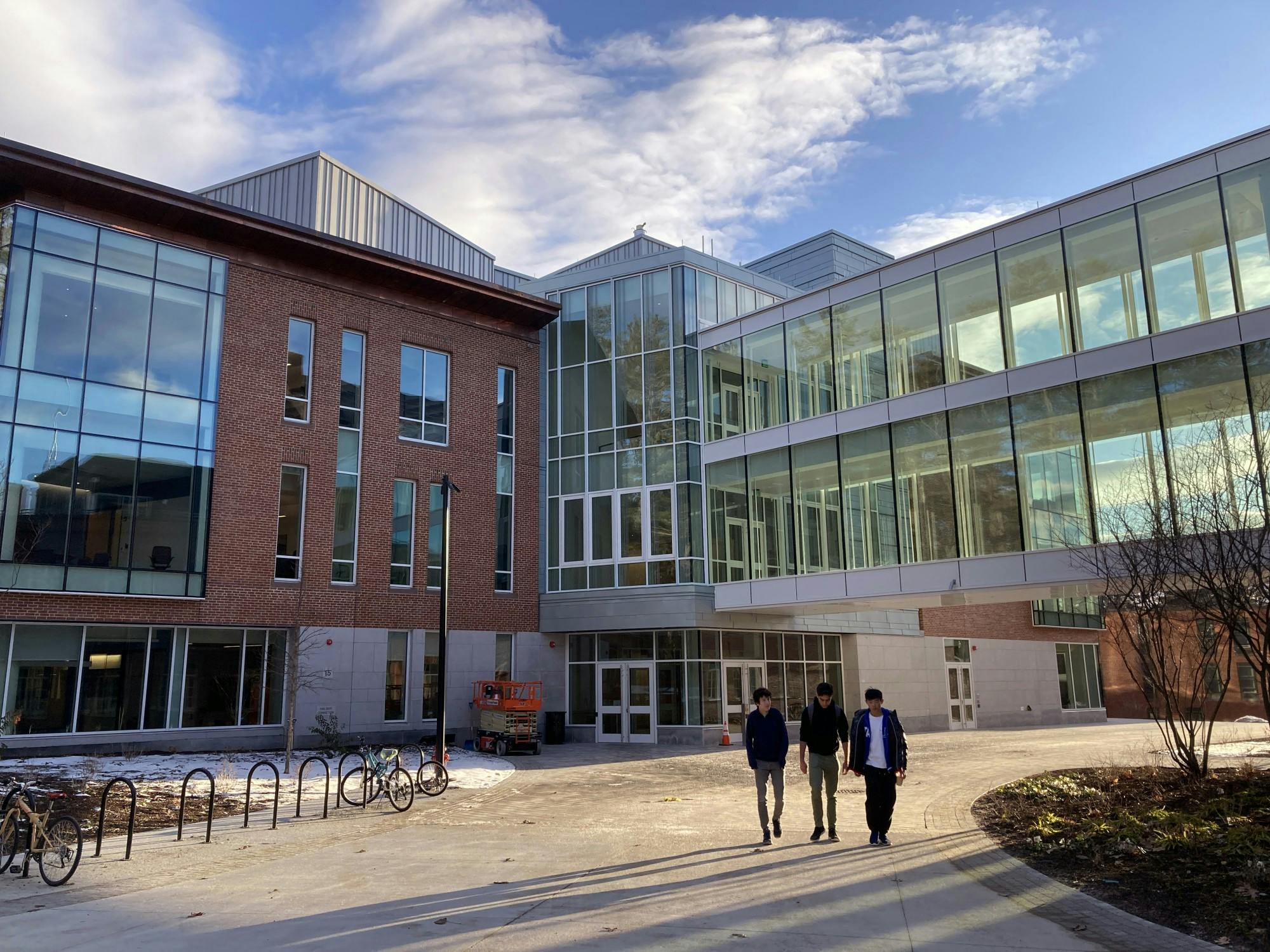In March, the College unveiled the new Engineering and Computer Science Center, a 160,000 square foot complex located at the end of Tuck Drive, to positive reactions from students and faculty. The $200 million building, which began construction in October 2019, was designed by the HGA architecture firm and funded entirely by donations. Dedication of the building is scheduled for this spring.
The project was conceived as part of the Call to Lead campaign and combines the Department of Computer Science, the Magnuson Center for Entrepreneurship, the Digital Arts, Learning & Innovation Lab, the College’s electron microscope and parts of Thayer School of Engineering into one building, according to the department of computer science’s website. The Center also doubles the size and potential faculty count of the existing Thayer engineering complex, according to HGA’s website.
“Being able to have engineering, computer science and then also the Magnuson Center for Entrepreneurship under one roof, I think only great things are going to happen,” Thayer dean Alexis Abramson said. “We will definitely see more educational opportunities like curricular and co-curricular things start happening.”
According to DALI lab director Tim Tregubov, computer science students now have easy access to the Thayer Maker Space and other builder technologies, which were previously located what felt “like a world away,” a half-mile walk from the computer science department’s former housing in Sudikoff. Tregubov added that the ECSC’s architecture — which consists of a shared entryway, large atrium and abundant natural lighting — facilitates community and collaboration, especially compared to the “dismal” Sudikoff.
“I think those serendipitous conversations that you get when you’re walking through a lobby — a shared single point of entry — are very important,” Tregubov said. “They spur a lot of creativity, innovation, because you see somebody and you’re like, ‘It has been on my mind to talk to you about ‘X.’’”
Students and faculty responded positively to the building’s architecture and offerings.
“I’m certainly excited,” prospective computer science major Alejo Rincon ’25 said. “Having that space in itself can be very conducive to helping CS students in general, because before [it opened] I’ve had all my CS classes in the psychology building …[which] seems kind of out of place in terms of where it actually is.”
Daniel Westphal ’23, a computer science modified with human-centered design major agreed that the space “adds to the CS community,” also pointing to the building’s architecture and shared learning spaces.
“It is a beautiful building,” he said. “It has a ton of conference rooms that are really conducive towards groups studying, and it’s very exciting overall … to have a new place on campus to explore that we have not seen yet, especially considering how old Sudikoff was.”
Thayer associate dean of undergraduate education Douglas Van Citters also praised the building’s open spaces and the frosted windows that surround internal work spaces, noting that they allow occupants to sense others’ activity without violating privacy. He added that the architecture has encouraged students to visit the space.
“We’re bringing all of Dartmouth’s campus into this building,” Van Citters said. “It doesn’t feel like it’s the engineering building. As a Dartmouth alum, I love the ‘One Dartmouth’ feeling that comes along with it.”
The new construction also offers a 340-vehicle parking garage, the website said, as well as bike storage, locker rooms, shower and nursing rooms, DALI lab faculty director and computer science research professor Lorie Loeb said. Among the building’s classrooms and conference rooms are three technology-enabled active learning (TEAL) classrooms, characterized by large screens and pod seating, Tregubov added. Loeb said that “the whole [architectural] team” has been “super responsive in terms of the [audiovisual] needs and trying to make sure that [the building] works for everybody.”
Abramson said that the Back of the Napkin Cafe, named to capture the Center’s spirit of innovation and entrepreneurship, will hopefully open in the next couple of months.
In addition to the new cafe, the building will continue to change as it adapts to the community’s needs, including fixing minor design flaws — such as a power box obstructing a projector, lights refusing to dim, doors knocking into lights and faulty paper towel dispensers, according to Van Citters and Loeb. Van Citters explained that these problems are merely “growing pains” associated with a new building and will not pose a long-term problem.
“I’d rather have [these minor design flaws] than something that doesn’t work because it’s too old and broken,” Van Citters said.
According to Abramson, some faculty and research labs have yet to move into the new building. As of now, the entire computer science department has relocated and all of the biological and chemical engineering faculty will move shortly, she said.
While the ECSC opened for classes in the spring, the building does not contain auditoriums for extremely large courses. Westphal said that some peers are still taking classes elsewhere, due to large course rosters. Van Citters explained that students can instead utilize lecture halls in nearby buildings, like Cummings Hall, which can seat 120 to 130 students.
“I think the space that we have is extremely high value,” Van Citters said. “[Small classrooms speak] more to the hands-on education that both computer science and engineering provide.”
Despite minor technical problems, Van Citters expressed his gratitude for the building’s completion.
“In the end, somebody had a vision and that vision is shared between the leaders who allowed this to happen and the folks who donated the money to make it happen,” Van Citters said. “I really want that gratitude to come forward from everybody here, because it’s awesome. It makes my job so much more rewarding.”




